I don't find it obvious. The key phrase here is 'in a picture'. Had you said 'in a scene' I'd agree, but both cropping and shifting change the way in which the scene is projected onto the picture. As regards perspective, both affect the picture-relative positions of the vanishing points.
[/quote]
Maybe I put it badly, I actually meant scene, but I think it can be both but scene and a picture in its uncropped form. Let's immagine I make a print with a wide angle lens. I then decide to crop the picture. I can change the apparent angle of view, or I can shift the convergence point, changing the angle of view, with the inevitable crop. The angular relationship of projection lines leading to the vanishing point or points remain unchanged.
Maybe these two quick sketches make my point clearer.
The convergence point has been shifted in the camera, using lens movements. The same effect could be achieved using a wider lens, and then cropping
We can change the focal length of the lens by zooming in, or crop a larger image but the lead lines remain constant.





